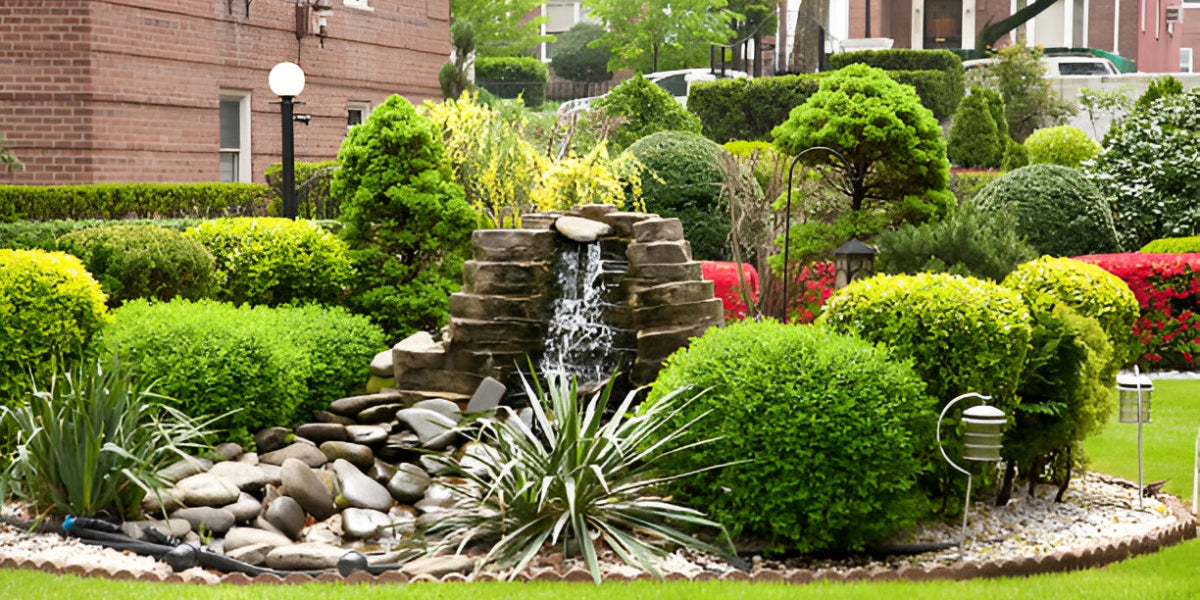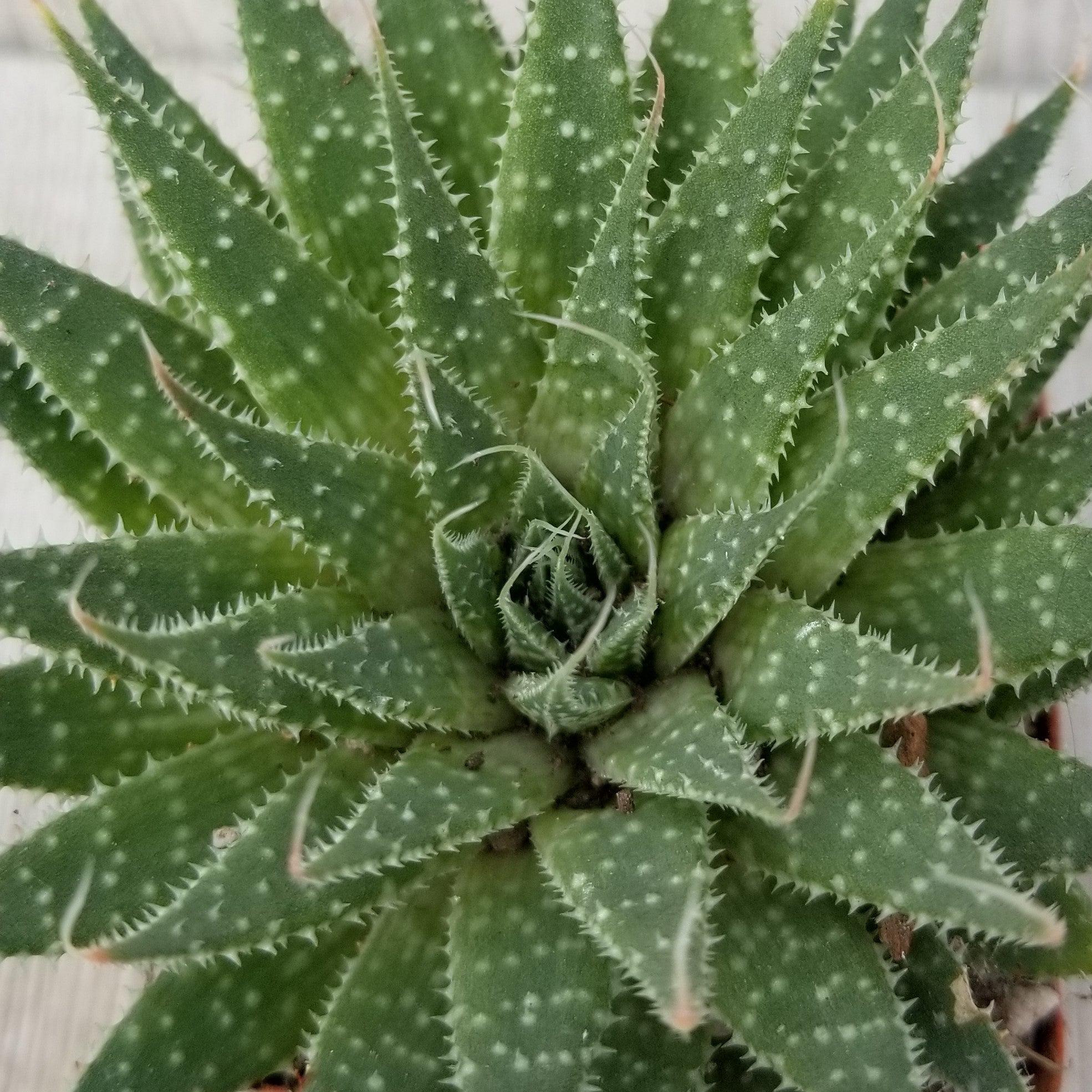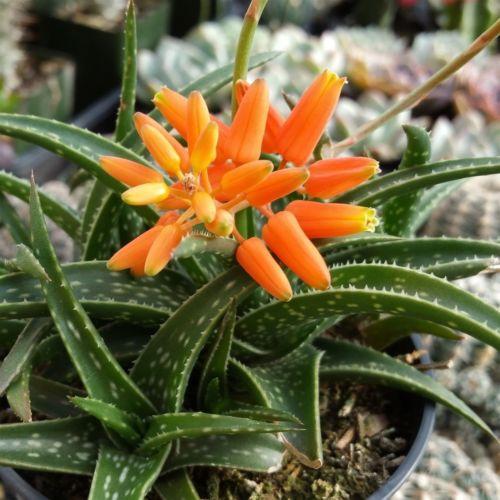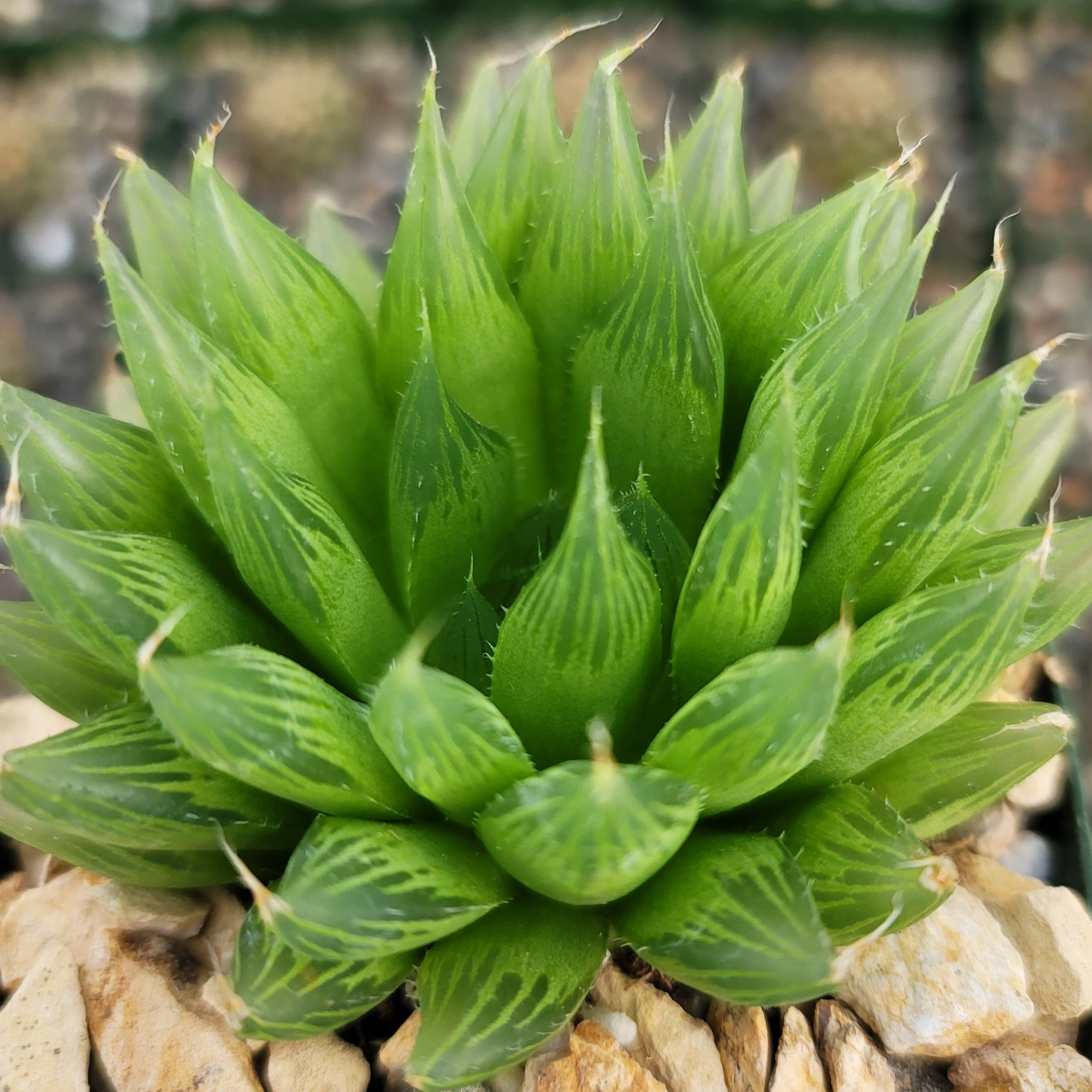Agave americana – Everything You Need to Know!
Updated: January 28, 2025

Agave Americana is the most popular type of Century Plant, and has a rich history that dates all the way back to the Aztecs. With its ability to store water in its leaves, this succulent has adapted to survive in the driest of deserts, making it a fascinating example of nature's resilience.

Agave Americana has several other common names such as American aloe, Maguey plants, and spiked aloe. It originates in the southwestern United States and Mexico but is now grown all over the world.
Despite being known as "American aloe," Agave americana is not a member of the same Aloe family, even though they are both classified as types of Asparagus plants.
This large, majestic plant can grow up to 6 feet tall and 12 feet wide, making it a striking addition to any landscape or indoor space.
Note that it is a slow-growing plant, taking almost 30 to reach its full size.
One of the defining features of the American agave is its thick, fleshy gray-green leaves with sharp spines and a waxy texture. These leaves form a rosette pattern, giving the plant a unique and architectural shape.
The leaves are also incredibly resilient, able to store water, and withstand harsh environmental conditions. It is well-known for its impressive Agave americana flower stalk, which can shoot up to 25 feet high and produce numerous yellow flowers.
Agave Americana is a low-maintenance plant that thrives in arid and semi-arid regions. It is well-adapted to drought conditions and can survive with minimal water, making it an excellent choice for xeriscaping. Its adaptability and ability to thrive in challenging environments have made it a staple in many botanical collections.
Agave Americana has a rich cultural significance. It has been used by indigenous peoples in Mexico for centuries for various purposes. The plant's sap, known as aguamiel, was fermented to make pulque, a traditional alcoholic beverage. Additionally, the fibers from the leaves were used to make ropes, mats, and clothing. The plant's sharp spines also served as needles in ancient times. It has become a symbol of Mexican culture and tradition, often appearing in art, literature, and folklore.
Agave Americana has a Massive Majestic Bloom
The blooming of the Agave Americana is a rare and spectacular sight. The name "Century Plant" likely originated from the fact that the plant takes a long time to bloom, and the fact that it was believed to bloom only once in its lifetime.
However, with proper care and conditions, it can live for many decades and produce multiple offsets, making it a long-lived and rewarding plant to cultivate.
After 10-30 years of growth, the plant suddenly shoots up a towering flower stalk, reaching heights of up to 25 feet. As the flower stalk emerges, it's adorned with clusters of yellow-green flowers that bloom in sequence, starting from the bottom and moving up.
The blooms are tubular and have a sweet, slightly musky fragrance that attracts pollinators like bees, butterflies, and hummingbirds.

The flowering process typically takes several weeks to a few months, depending on environmental conditions. During this time, the plant focuses its energy on seed production, and the flowers will eventually give way to seed pods. It's a fleeting moment in the plant's long lifespan, but one that's crucial for its reproduction.
After the seeds have been dispersed, the plant will begin to decline, eventually dying off. But even in death, the Agave Americana century plant leaves behind a legacy – its offsets, or "pups," will continue to grow and thrive, ensuring the cycle begins anew. Like other monocarpic century plants, it devotes all of its energy to producing a spectacular flowering stalk once in its lifetime, before gracefully bowing out.
Pro Tip
Plant it away from foot traffic because the needle-sharp spines on the leaf tips can be dangerous to people and pets.
Agave Americana Plant Care Guide
Agave Americana is a hardy and adaptable succulent plant that thrives in challenging conditions, making it perfect for busy gardeners. This drought-tolerant succulent requires minimal care and can survive with infrequent watering, making it an ideal choice for water-conscious gardeners. With its ability to tolerate extreme temperatures and neglect, Agave Americana is a low-maintenance addition to any garden or indoor space. Despite being simple to grow, agave plants do require a few "needs" to be healthy. Below, you can find out more about how to take care of your century Agave americana.
Quick Reference

Bloom Season

Flower Color

Growth Rate

Hardiness Zone

Mature Size

Plant Type

Sun Exposure

Toxicity

Watering Needs
How Often to Water Your Agave americana – Tips & Tricks
A good rule of thumb is to water your Agave Americana once every 2 weeks during the growing season and once a month during the dormant season, but this may vary depending on your specific climate and soil conditions.
This American agave plant is an extremely drought-tolerant succulent that can survive with minimal watering. In fact, it's more likely to die from overwatering than underwatering! It's important to consider the soil moisture levels when watering your Americana agave. Stick your finger into the soil about an inch deep, and if the soil feels dry, it's time to water. If it's already moist, wait a few more days before watering again.
In the spring and summer, during the growing season, water your Agave century plant sparingly, only when the soil is completely dry to the touch, usually every 10-14 days. Its ability to store water in its leaves makes it a low-maintenance choice for busy gardeners.
In the fall and winter, during the dormant season, it requires even less water, as it's not actively growing. You can reduce watering to once a month, or even less often if you live in a humid climate. Remember, this American agave is adapted to survive in harsh, dry conditions, so it's better to err on the side of caution and underwater than to overwater.
Understanding the Lighting Needs of Agave Americana
When grown indoors, your Agave Americana prefers bright, indirect light for at least 4-6 hours a day. Placing it near a south-facing window or under a skylight is ideal. However, direct sunlight can be too intense and may cause burning, so it's essential to provide some shade. East- or west-facing windows are also suitable but avoid placing your Agave century plant in a spot with low light, as it may not thrive.
Remember, it's also important to consider the intensity of light. It can tolerate some direct sunlight, but prolonged exposure may cause damage. If you notice brown spots or crispy leaves, it's likely due to too much direct light. Move your plant to a spot with bright, indirect light to prevent further damage.

For outdoor cultivation, the century plant loves full sun to partial shade for at least 6-8 hours a day. In warmer climates, it's best to provide some afternoon shade to prevent scorching. In cooler climates, full sun is tolerated but be cautious of frost. Agave Americana can tolerate some shade, but too little light may lead to weak and spindly growth.
In outdoor settings, be mindful of the time of day and season. During peak summer months, provide some shade to prevent scorching. In winter months, your Agave plant can tolerate frost but may need protection from extreme cold. By understanding and meeting the lighting needs of your Agave, you'll be rewarded with a thriving and majestic plant.
Optimal Soil and Balanced Fertilizer for Healthy Growth
The century plant prefers well-drained soil that is rich in organic matter. A mix specifically designed for cacti and succulents is ideal, as it will contain the right balance of ingredients to prevent waterlogged soil. This will provide excellent drainage and aeration for the roots. Instead, make or buy a well-draining potting mix, or ideally use our specialized succulent potting mix that contains 5 natural substrates and mycorrhizae to promote the development of a strong root system that helps your agave succulent to thrive.
When it comes to fertilizing your Agave Americana, a balanced (5-10-5), water-soluble NPK fertilizer is the best choice. Dilute the fertilizer to half the recommended strength to avoid burning the roots. Feed your plant during the growing season, once a year in the spring which will provide nutrients throughout the growing season. Additionally, refrain from fertilizing during the dormant season (fall and winter), as the plant is not actively growing. Overfertilization can lead to weak and leggy growth, so it's essential to strike the right balance.
Agave Americana’s Ideal Climate: Temperature and Humidity Essentials

When grown indoors, this most popular type of century plant prefers a moderate temperature range of 65-75°F during the day and no lower than 55°F at night.
This allows the plant to thrive without experiencing stress from extreme temperatures. Avoid placing your plant near heating or cooling vents, fireplaces, or drafty windows, as sudden temperature fluctuations can cause damage.
It also prefers a relatively low humidity environment, ranging from 40-50%.This can be achieved by placing the plant on a tray filled with water and pebbles or using a humidifier. Be cautious not to over-humidify, as this can lead to root rot and other issues.
For outdoor cultivation, the Americana thrives in zones 9-11, where the temperature and humidity conditions are suitable.
In these zones, the plant can tolerate summer temperatures up to 90°F and winter temperatures as low as 40°F. Average humidity levels ranging from 50-60% are also tolerated.
In outdoor settings, Agave Americana may still require some protection during extreme weather conditions. Providing shade cloth or shade trees can filter intense sunlight, while mulch or straw can insulate the soil. Windbreaks or frost blankets can also protect the plant from harsh winds and frost. By understanding these requirements, you'll be able to provide your Agave Americana with the ideal environment to flourish.
Our Favorite Agave Americana Varieties
The Agave americana the King of Century Plants, is the most iconic and widely recognized member of its family. Known for its majestic size and striking appearance, the Agave americana is the quintessential century plant, revered for its durability and striking architectural form.
At the heart of this category, the Agave americana stands out as the main variety, embodying the classic characteristics that have made century plants so popular. Below, you'll find some of the top hybrids and variations, each offering unique traits while maintaining the core beauty of the Agave americana. These hybrids are exceptional alternatives, showcasing diverse forms, sizes, and color patterns while staying true to their regal lineage.

1
Century Plant – Agave americana
BUY AT PLANET DESERTkeypoints:
- USDA Hardiness Zones: 8,9,10,11,12
- Blooming Period: Once in a lifetime
- Mature Size: 6 ft. tall, 12 ft. wide
- Flower Color: Greenish, Yellow
Agave American is once again the most popular type of Century Plant and is a striking succulent known for its large, rosette-forming leaves with sharp spines along the edges. This plant is renowned for its architectural form and can grow up to 6 feet tall and 12 feet wide. It thrives in arid conditions, making it a perfect choice for drought-tolerant landscapes. Requiring minimal maintenance, this agave century plant is highly resilient, needing little more than occasional watering in extremely dry periods. It can thrive in poor soils and is resistant to pests, making it an ideal, low-maintenance addition to xeriscapes and other dry gardens. Learn more...

2
Variegated Century Plant - Agave americana ‘variegata’
BUY AT PLANET DESERTkeypoints:
- USDA Hardiness Zones: 8,9,10,11
- Blooming Period: Once in a lifetime
- Mature Size: 6 ft. tall, 10 ft. wide
- Flower Color: Greenish, Yellow
The Variegated Century Plant is a low-maintenance succulent plant known for its large, rosette adorned with yellow or cream-colored variegation. The leaves are thick, fleshy, and spined, growing up to 6 feet long, giving the plant a dramatic aesthetic appeal. This drought-tolerant succulent thrives in full sun and well-draining soil, making it an excellent choice for low-maintenance gardens. It requires minimal care, with infrequent watering and little attention once established. The plant can live for decades, but it blooms only once in its lifetime, producing a tall flower stalk before it dies. Its impressive foliage and ease of care make it a popular choice for xeriscaping and container gardening. Learn more...

3
White Striped Century Plant - Agave americana mediopicta alba
BUY AT PLANET DESERTkeypoints:
- USDA Hardiness Zones: 8,9,10,11
- Blooming Period: Once in a lifetime
- Mature Size: 2 ft. tall, 3 ft. wide
- Flower Color: Yellow, Green
The White Striped Century Plant is a captivating succulent distinguished by its unique central white stripe that runs the length of each blue-green leaf, creating a striking contrast. This eye-catching feature sets it apart from other agaves, making it a standout in any garden or landscape. Growing in a compact rosette form, it reaches about 3-4 feet in height and width, making it more manageable than its larger relatives. Its dramatic foliage and architectural presence make it a focal point in drought-tolerant gardens, rock gardens, or as a stunning container plant. Like other agaves, it requires minimal care, thriving in full sun with well-draining soil and only occasional watering, making it an excellent choice for those seeking both beauty and ease of maintenance. Learn more...

4
Narrow Leaf Century Plant - Agave americana striata
keypoints:
- USDA Hardiness Zones: 7,8,9,10,11
- Blooming Period: Once in a lifetime
- Mature Size: 24 in. tall, 34 in. wide
- Flower Color: Yellow, Green
The Narrow Leaf Century Plant is a distinctive low-maintenance succulent prized for its slender, elongated tough leaves, which feature striking stripes of light green and yellow. Unlike the broader leaves of typical agaves, this variety's narrow, upright foliage creates a more refined and graceful appearance, adding vertical interest to any landscape or garden. The plant forms a symmetrical rosette, making it a perfect choice for both large and small spaces. Its drought-tolerant nature and low-maintenance requirements make it ideal for xeriscaping or container gardening. Unique for its eye-catching variegation and slender leaves, the Narrow Leaf Century Plant is a stunning choice for those looking to add a touch of elegance to their outdoor spaces.

5
Agave americana var. oaxacensis
keypoints:
- USDA Hardiness Zones: 7,8,9,10,11
- Blooming Period: Once in a lifetime
- Mature Size: 6 ft. tall, 8 ft. wide
- Flower Color: Yellow, Green
The Agave americana var. oaxacensis is a magnificent and resilient plant that adds an exotic touch to any garden or landscape. Its striking rosette of spiky leaves, combined with its ability to thrive in challenging conditions, makes it a popular choice among gardeners and landscape designers. Whether used as a focal point in a rock garden, a striking container plant, or a hardy addition to a xeriscape, this agave variety is sure to impress. With minimal care requirements and the ability to propagate new plants from offshoots, it is a plant that will provide beauty and interest for many years to come.

6
Agave americana var. expansa
keypoints:
- USDA Hardiness Zones: 8,9,10,11
- Blooming Period: Once in a lifetime
- Mature Size: 12 ft. tall, 8 ft. wide
- Flower Color: Yellow, Pale Green
The Agave americana var. expansa is a distinctive variety of the Agave americana, known for its broad, blue-green leaves that form a wide, open rosette. This variety, often referred to as the "Expansive Century Plant," is recognized for its spreading growth habit compared to other agave varieties. The leaves can reach up to 12 feet in length, creating a dramatic, architectural presence in the landscape. Its robust size and striking appearance make it a standout choice for gardeners seeking a bold, resilient plant. Its impressive size and architectural shape make it a great focal point in xeriscaping designs, and its low-maintenance requirements ensure it will remain a stunning addition to your landscape with minimal upkeep. Additionally, it produces vibrant yellow flowers on tall stalks after 10-15 years, adding an extra layer of beauty to this already impressive succulent.

7
Agave americana var. Protamericana
keypoints:
- USDA Hardiness Zones: 7,8,9,10,11
- Blooming Period: Once in a lifetime
- Mature Size: 6 ft. tall, 10 ft. wide
- Flower Color: Yellow, Green
The Agave americana var. protamericana, is another stunning variant of the iconic Century Plant, boasting an impressive presence in any landscape. Its robust, symmetrical rosettes of thick, fleshy leaves have a vibrant blue-green color and red-brown margins. As a true showstopper, this variety produces towering flower stalks, often reaching 15-20 feet high, adorned with bright yellow blooms that attract pollinators and add a dramatic pop of color. The plant's massive size, architectural shape, and striking foliage make it a popular choice for adding a touch of desert drama to gardens and landscapes. Its statuesque presence and rare, spectacular blooms have captivated people for centuries, earning its place as a timeless and coveted addition to any outdoor space.
RELATED ARTICLE:
If you want to learn about types of Century Plants, click here to read All About Century Plants.
Potting and Repotting Essentials
- The agave century plant typically needs to be repotted every 2-3 years, as it outgrows its container.
- Choose a pot that is only slightly larger than the previous one, as Agave Americana prefers to be slightly root-bound.
- Use a well-draining potting mix specifically designed for cacti and succulents, and a pot with good drainage holes to prevent waterlogged soil.
- When repotting, gently remove the plant from its pot, taking care not to damage the roots or disturb the root ball.
- Trim any dead or damaged roots before placing the plant in its new pot, and water sparingly until established. It's best to repot in the spring when the plant is actively growing and avoid repotting during the fall or winter when the plant is dormant.
- By repotting your plant correctly, you'll give it the room it needs to continue growing and thriving.

Americana Agave Century Plant Propagation: Tips and Tricks
To propagate Americana Agaves, you can divide offsets from the parent plant, collect seeds from mature flowers, or leaf cuttings from the rosette. Like other plants, it's important to provide well-draining soil and ample sunlight for successful propagation. For your convenience, we go into detail about each below.
Offsets (Pups)
- Wait until the offsets have developed their own roots and are about 1-2 inches in diameter.
- Carefully remove the offset from the mother plant, making sure to leave some roots attached.
- Allow the offset to dry for a few days to form a callus before planting.
- Plant the offset in well-draining soil, and water sparingly until established.
- Keep the soil moist but not waterlogged and provide bright indirect light.

Leaf Cuttings
- Take 2–3-inch leaf cuttings from the mother plant, using a sharp, clean tool.
- Allow the cuttings to dry for a few days to form a callus, which helps prevent rotting.
- Plant the cuttings in well-drained succulent soil, burying them up to the base of the leaf.
- Water sparingly until roots develop, and then gradually increase watering.
- Keep the soil moist but not waterlogged and provide bright indirect light. When handling this plant, care should be taken because the leaf tips are sharp and may be harmful.
Seeds
- Sow seeds in well-draining soil, about 1/4 inch deep and 1-2 inches apart.
- Water gently but thoroughly and keep the soil consistently moist but not waterlogged.
- Provide warm temperatures (around 70-80°F) and bright indirect light.
- Seeds can take several months to germinate, so be patient and keep the soil moist.
- Once seedlings emerge, they gradually increase watering and provide more light as they grow.
- Spread the holiday cheer by propagating new plants from stem cuttings to share with friends.
Agave Americana - Uses & Benefit
Beverages: In Mexico, agaves are referred to as mezcales, and "mezcal" is the distilled spirit produced from the fermented heart of the agave plant, known as the piña. The agave plant belongs to the Agavaceae family, which includes nearly 200 species. Agave americana is one of the species used to produce Mezcal, but the specific mezcal known as tequila is made exclusively from Agave tequilana, or blue agave. Mezcal can be made from over 30 different agave species, varieties, and subvarieties, whereas tequila is strictly produced from blue agave. This variety in agave species contributes to the diverse flavors of mezcal.
Fibers: Agave americana leaves produce pita fibers, used in ropes, nets, bags, and leather embroidery. Pulque and maguey fibers, along with pulque, played significant roles in Mexico's pre-Columbian economy.
Aesthetic Appeal: It is popular in landscaping because of its dramatic appearance and low maintenance requirements. It makes an excellent specimen plant in rock gardens and desert gardens. Its sharp spines and tough leaves generally deter deer and rabbits, making it an excellent choice in areas where these pests are prevalent.
Pests & Problems: How to Identify and Fix Issues with Various Types of Agave Americana Plants
Agave century plants are susceptible to pest infestations such as agave snout weevils and agave mites. Look for signs of wilting, discoloration, or chewed leaves to identify a potential pest problem. If pests are present, consider using insecticidal soap or neem oil to control infestation and prevent further damage to your plant.

- Aphids: Small, soft-bodied insects that feed on plant sap, causing curled or distorted leaves. Aphids can also transmit plant viruses. Check for aphids on the undersides of leaves and stems. Control by spraying with water or insecticidal soap.
- Mealybugs: White, cottony insects that feed on plant sap, causing stunted growth and yellowing leaves. Mealybugs secrete a sticky substance called honeydew, attracting ants. Isolate infested plants and treat them with insecticidal soap or neem oil.
- Scale insects: Small, armored insects that feed on plant sap, causing stunted growth and yellowing leaves. Scale insects can also secrete honeydew, attracting ants. Check for scales on stems and leaves, and control by scraping off or using insecticidal soap.
- Spider mites: Tiny, spider-like insects that feed on plant sap, causing yellowing or bronzing of leaves.
Spider mites thrive in hot, dry conditions. Control by spraying with water or insecticidal soap.
- Snails and slugs: Slender, slimy pests that chew holes in leaves, especially at night. Snails and slugs thrive in moist environments. Control by hand-picking, using copper tape barriers, or trapping with beer.
- Overwatering: Too much water can cause roots to rot, leading to soft, mushy leaves and plant death. Check soil moisture by sticking your finger in it. Allow soil to dry slightly between waterings.
- Underwatering: Too little water can cause leaves to become scorched or wrinkled. Water thoroughly, allowing excess water to drain. Increase frequency during hot, dry spells.
- Frost damage: Agave americana is sensitive to frost, which can cause leaves to become soft, mushy, or discolored. Protect plants from frost using blankets or bring potted plants indoors.
Where to Buy the Century Plant Agave Americana?
When it comes to buying century plant, unless you have a local nursery that specializes in cacti and succulents; then you may have a hard time finding Agave americana near you. Most of the types of Agave americana listed above are all available at Planet Desert. You can just click the buy link on any of the varieties of Agave americana on our list above, or feel free to explore more types of agave plants for sale here.
We have the world's largest selection of Cactus & Succulents that can be shipped anywhere in the United States and are guaranteed to arrive happy & healthy.
Agave Americana Quick Reference Growing Guide
| Bloom Season | Once in a lifetime |
|---|---|
| Botanical Name | Agave americana |
| Common Name | Century plant, American century plant |
| Dormancy | Winter |
| Family | Asparagaceae |
| Flower Color | Greenish yellow |
| Genus | Agave |
| Growth Habit | Rosette |
| Growth Rate | Slow -- Moderate |
| Hardiness Zone | 8, 9, 10, 11 |
| Mature Size | 6 ft tall, 12 ft. wide |
| Native Area | Mexico |
| Plant Type | Perennial succulent |
| Propagation | By offsets, seeds |
| Resistance | Drought-tolerant, pest-resistant, mild frost tolerant |
| Soil PH | 6.5, Acidic, Neutral |
| Soil Type | Specialized succulent potting mix |
| Special Features | Easy to maintain, Easy to grow |
| Sun Exposure | Full Sun, partial shade |
| Toxicity | Mildly toxic to humans--Mildly toxic to pets |
| Watering Needs | Low |
Final Thoughts
Overall, the Agave americana century plant is a timeless and versatile succulent that combines dramatic aesthetics with hardy resilience, making it a standout choice for any garden or landscape. Native to Mexico, it is known for its impressive size, striking rosettes of spiky, blue-green leaves, and its ability to thrive in arid conditions, this plant is ideal for those seeking low-maintenance yet impactful greenery. Whether you're looking to enhance a xeriscape, create a bold focal point, or simply enjoy a plant that requires minimal care, Agave americana offers both beauty and practicality.
Frequently Asked Questions
-
Is Agave americana the same as aloe vera?
Agave americana and Aloe vera are two distinct succulent species, often confused due to their similarities. However, they belong to different genera and exhibit unique characteristics. Agave americana, also known as the American Aloe or Century Plant, boasts thick, fleshy leaves with sharp teeth and can grow up to 6 feet tall, whereas Aloe vera has softer teeth and is commonly used for its medicinal and cosmetic properties. While both plants have medicinal properties, Aloe vera is more widely used for its soothing gel and juice and is also more cold-hardy than Agave americana. Despite their similarities, these two plants are not the same, and their differences set them apart in terms of appearance, size, hardiness, and uses.
-
Why is Agave americana called a century plant?
Aquae Americana is called a "Century Plant" because it is popular belief that they only bloom once every 100 years. But in reality, they take approximately 10 to 30 years to bloom, but not exactly 100 years. This name is a bit misleading, as it was thought to take a century to bloom when it was first discovered. However, the name stuck, even though the actual time frame is shorter. When it does bloom, the plant produces a tall stalk with yellow flowers, but then it dies, making the blooming event a rare and significant occurrence. This unique life cycle contributes to the plant's mystique and its nickname, the "Century Plant".
-
What is the lifespan of the Agave americana plant?
The lifespan of the Agave americana typically ranges from 10 to 30 years in the wild, although some specimens have been known to live up to 50 years or more in ideal conditions. After blooming, the plant dies, but it produces offsets or "pups" around its base, which can be removed and replanted to create new plants. This process allows the plant to perpetuate itself and essentially live on through its offspring. So, while the individual plant may die after blooming, the genetic material lives on through its progeny.
-
Is tequila made from Agave Americana?
Agave Americana is not used to making Tequilla but is used to making Mezcal. Tequila is made from the blue agave plant (Agave tequilana). While both plants are part of the agave genus, they are different species. Agave tequilana is primarily cultivated in the Jalisco region of Mexico, where tequila is produced. The blue agave plant takes around 8-12 years to mature, and its heart, or piña, is harvested and distilled to create tequila. Agave americana, on the other hand, is not typically used for tequila production due to its lower sugar content and different flavor profile.
























